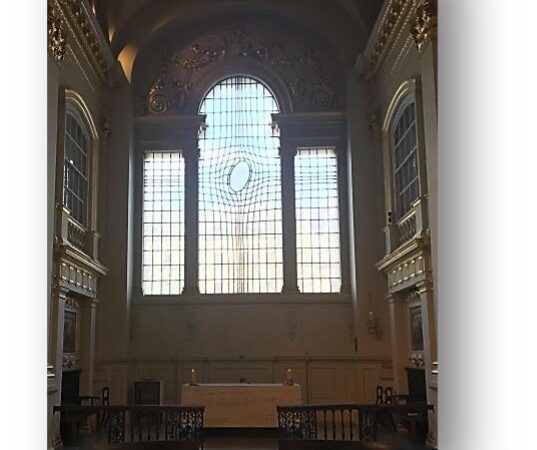THE ASCENSION OF OUR LORD 2021 | A Sermon on Luke 24: 44-53 (RCL) | by David Zersen |
There are events and festivals, experiences or impressions that don’t allow rational exploration. Perhaps you can think of some. A time when you couldn’t explain what happened or a moment that defines you even if you have no words for it! I don’t think of myself as a mystic, a person who courts the unexplainable or tinkers with the irrational However, most of us admit that an attempt to rationalize everything leads to more questions and less solutions. Today’s lesson brings us face to face with a reality that only pictures and images approach. It’s fair, therefore, to admit this lesson will bring some challenges and a sense of wonder.
BREAKING THE GRID
Attempting to come to grips with the full meaning of the Ascension story is not easy. If we’re to use words, we don’t have much to go on. Verse 51 of Luke’s last chapter simply says “while he was blessing them, he left them and was taken up to heaven.” “He left them.” Those are the hard words for the disciples—and for any of us who are left behind when someone we love leaves us, whether for a time, or for good. Tim LeHaye wrote sixteen novels, later made into films and video games, about what happens to people who have been “left behind”. Despite the rootage in dispensational theology, the stories became wildly popular because being left behind can be a scary situation. The producers of the “Home Alone” film series give us a “Kevin” who can help us. Be careful and clever enough to deal with all the crazy things than can happen when you’re on your own! At least that’s how one does it in a film!
The disciples in our story were bewildered about their abandonment and had to think back to the things Jesus had taught them in order to make sense out of their new situation. It’s interesting for us to reflect on what they said and did. It’s also interesting as we try to make sense of their challenge to see what artists have done with this story—artists being people who try to use imagery to convey truth when words fail them.
I’m thinking of three artistic expressions that artists have used to make sense of the Ascension story, specifically of the impact of the moment when our text says, “He left them, and was taken up into heaven.”
The first image that comes to mind is not only one that I’ve had with me since childhood, but one that well-known artists down through the centuries have used. If you google “Ascension Art”, you will find many of these images. They come as close as possible to a realistic portrayal of the words “left” and “taken up”. Giotto, Veronese, Rembrandt, Rubens and Dali all tried to express their thoughts and feelings about Jesus’ ascension, his leaving the disciples and being taken up into heaven. The impression on the disciples’ faces is one of fear or awe. The description of Jesus’ disappearance allows for extended or outstretched hands and arms that serve to capture the supernatural lift that apparently draws him upward.
For the most part this realistic attempt to deal with the ascension’s meaning began to disappear as modern views of cosmology changed. Heaven was no longer “up”, but more likely “out” and even an “out” pursuing an infinity that defies traditional meanings. Furthermore, contemporary artists seem less concerned with where Jesus went than they are concerned with what the disciples are to do in Jesus’ absence. Newer artists attempt to explore mystical and supernatural expressions of the ascension with expressionist plumes of fire and impressionist spectrums of color. Some of it is spectacular, particularly in an attempt to say: “What was going here was beyond our understanding. We know that a division took place between Jesus and the disciples, between what had been and what would now take place.” The contemporary artists seem more concerned with what will happen to the bewildered disciples, to those who know they are home alone.
The second example I’d like to share employs a new approach that I think can help us make sense of the final day in the so-called festival half of the church year, the day when Jesus left his disciples, yet gave them power to understand the Scriptures and to preach repentance and forgiveness in his name to all nations. It is not a day to look back; rather it is one to look forward.
The second example is from a newer window in the chancel of St. Martin in the Fields at Trafalgar Square in London. In the bombing of 1940, a stained glass window in the chancel wall was destroyed. It was a Victorian, multi-colored, realistic, biblical image that allowed one to “see” with the mind’s eye “exactly” how the original setting may have looked. When the bomb fell and the window was destroyed, 7000 people were packed in the cellar and many met their dead end. The new window would have to say something about new-beginnings, about the post-WWII world into which Jesus was sending his followers. Twenty-five artists submitted proposals and the one chosen was done by an Iranian woman, Shirazeh Houshiary.
The window is now clear glass with leaded divisions indicating the shape of the cross, symbolizing Jesus, and a burst, a rounded space at the crossbeam encouraging the viewer to look through, if not beyond, the window! It is a “God shaped hole,” some have said, a challenge to one who asks about the meaning of the ascension in a secular world. The new window introduces light, wonder, contemplation, encouragement. The new window does not give the details of a realistic, Victorian setting, but rather it helps to grasp a new insight. Jesus, who left us, is encouraging us not to get lost in the details of past experiences. He wants to show us that he has broken the grid, the framework that locks in the rigidities of past misunderstandings, foibles and failures. We are invited to enter with him into a new and open wide world in which love and service will allow us to embrace brothers and sisters everywhere. We are not left behind so much as we are thrust forward into a new world in which “repentance and forgiveness of sins will be preached in his name to all nations.” (Lk. 24:47)
The third artistic rendering of the ascension I’d like to share was once placed on a calendar published by Lutheran Brotherhood, a fraternal life insurance company of some years ago, now merged with Aid Association for Lutherans and having the new name, Thrivent. The stunning painting for one month of the year was done by a high school student whose name is no longer remembered by Thrivent. I would like to believe that he (I remember it was a young man) went on to become a great artist because this work had enormous impact on me. The image shows only the ascending feet of Jesus. As they rise, the grid that separates the future from the past or, say, heaven from earth in earlier language, is shattered. Colorful confetti falls everywhere below to prove that the result of the ascension is pure exuberance. It is an artist’s way of saying that although Jesus “left them,” the future is still ours, death is permanently overcome, confidence is our destiny and nothing can separate us from the love of God in Christ Jesus (Rom. 8:38).
For those who have pain, after a trauma or a feeling of abandonment, this text is very important. Jesus had come to “make all things new.” (Rev. 21:5) He had shattered the grid that locked our worldview into patterns that may have once seemed pretty to us, but ultimately led to dead ends. His crucifixion spoke powerfully to us who were comfortable with the way things had always been. We who were satisfied with anger and arrogance, hatred and violence, are told by the cross: “Let it end here!” It doesn’t have to be this way—ever again. We are freed to move into a new lifestyle marked by love and hope. Jesus reminds us that we have witnessed a life of generosity and service—and with his Gospel example empowering us, we can break through the grid that holds us back and enter the new possibility that his Father has promised.
Just as Jesus assured his disciples as he left them that everything had been fulfilled, everything written in the Law of Moses, the Prophets and the Psalms (Lk. 24:44), so this Feast of the Ascension, celebrated since the time of the apostles, assures us that there is no need for the earthly Jesus to remain among us. He promises to be with us in spirit to the end of the age (Mt. 28:20). As witnesses to the faith that empowers us to believe in what is eternally new, this day doesn’t speak about endings. It proclaims the assurance that the future is ours because in Jesus our God is not a God of the past but of the future.
As the author of Hebrews reminds us: “Therefore, since we are surrounded by such a great cloud of witnesses, let us throw off everything that hinders and the sin that so easily entangles. And let us run with perseverance the race marked out for us, fixing our eyes on Jesus, the pioneer and perfecter of faith. (12: 1-2)
The Ascension of our Lord is the last day of the Church Year, coming 40 days after Easter, and celebrated because it brings to an end the remembrance of the deeds of Jesus. For many, it is a day almost forgotten, coming as it does on a Thursday. Let it be a day, however, that leaves us with a sense of awe and wonder, a day to focus on the opportunities for love and service we may not yet have considered. As Fortunatus already sang of this day in the 600s, “Enlighten our minds, great Redeemer, order our ways in your peace.” Help us with you, our faithful Pioneer, to break through the human grids that restrain us and enter now the season in which your words regularly empower us.
—
Hymn: “Hail Thou Festival Day” Fortunatus (600 A.D.)
The Rev. David Zersen, D.Min., Ed.D.
President Emeritus, Concordia University Texas

